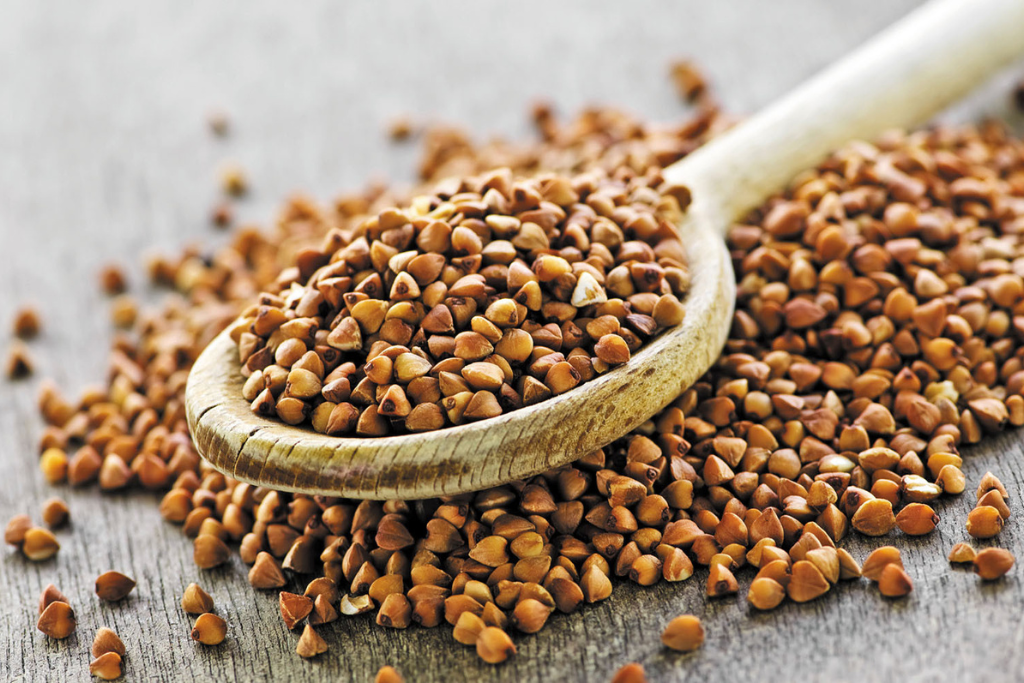Buckwheat’s Top 5 Health Benefits
Despite its name, buckwheat is not a type of wheat; in fact, it is not a grain at all. The seed comes from a flowering plant related to the rhubarb family and is believed to have originated in China around 6,000 years ago.
Grain and gluten are naturally absent from buckwheat. However, chefs and nutritionists frequently classify buckwheat as a grain due to its pyramid-shaped kernels, nutritional profile, and role in recipes.
Buckwheat deserves more praise than being grouped with grains because, besides its distinct flavor, it offers special nutritional advantages, benefits the environment, and has been a staple of meals globally for thousands of years. Buckwheat is used in various international cuisines, including Eastern European porridge, Italian pizzoccheri pasta, Japanese soba noodles, French crepes from Brittany, and Kasha varnishkes.
While it’s commonly used in gluten-free baking, buckwheat isn’t widely used in American cooking, though it has a rich history worldwide. If you haven’t yet, keep reading to learn why you should add buckwheat to your grocery list.
Types of Buckwheat
There are two main types of buckwheat grown for food: common buckwheat (Fagopyrum esculentum) and tartary buckwheat (Fagopyrum tartaricum). The primary differences lie in how they breed and the climates they prefer. Tartary buckwheat tolerates colder weather, while common buckwheat thrives in temperate climates.
Buckwheat Health Benefits: Great for Gut Health
Buckwheat offers many reasons for its inclusion in a healthy diet, particularly when it comes to digestive health. Since it is a whole food, it contains both soluble and insoluble fiber, which are vital for maintaining normal digestive function. Additionally, buckwheat serves as a prebiotic, promoting the growth of beneficial gut bacteria.
For those with gastrointestinal issues like IBS, buckwheat is an excellent option since it is low in FODMAPs. Studies show that pseudocereals like buckwheat are more satiating than other grains like rice and wheat, helping you feel fuller for longer.
Buckwheat as a Source of Superior Protein
One of the few plant-based proteins considered complete, buckwheat contains all nine essential amino acids necessary for human health. One cup of cooked buckwheat provides about 6 grams of protein, roughly equivalent to one large egg.
Buckwheat and Blood Sugar Regulation
Buckwheat is a good source of resistant starch, which passes through the small intestine undigested in its whole groat form. This reduces blood sugar spikes compared to refined grains like white bread, providing a lower glycemic index. Furthermore, buckwheat is rich in D-chiro-inositol, a soluble carbohydrate that may help regulate blood sugar, making it beneficial for diabetics.
Buckwheat May Encourage Heart Health
Buckwheat is one of the few foods with high concentrations of rutin, a potent antioxidant known for its heart health benefits. Found in green tea, figs, and unpeeled apples, rutin has anti-inflammatory properties and may reduce the risk of blood clots, improving circulation. Always consult your physician if you are on blood-thinning medications like warfarin, as rutin may interfere with them.
Buckwheat: Nutrient-Dense Gluten-Free Foods
Many gluten-free products are either highly refined or, unless fortified, low in fiber, vitamins, and minerals. Buckwheat, being naturally gluten-free, is a rich source of nutrients without the need for fortification. It contains vitamins A, B complex, C, and E, along with antioxidants that are more abundant than those in wheat and rice. Additionally, buckwheat is high in essential minerals like zinc, magnesium, phosphorus, manganese, and selenium. Among the two types of buckwheat, tartary buckwheat contains a higher total nutritional content than common buckwheat.
Where Can You Get Buckwheat?
Buckwheat groats can be found in bulk or packaged forms, such as Bob’s Red Mill buckwheat groats or Wolff’s kasha, which is made from 100% roasted buckwheat. You can also find buckwheat soba noodles in grocery stores, particularly in the Japanese food section. Be sure to check the labels as some varieties may contain wheat.
For those with celiac disease, look for a certified gluten-free label on products made entirely from buckwheat or a mix of buckwheat and brown rice flour. You may also find gluten-free buckwheat bread in the freezer aisle, such as gluten-free sourdough from Live Pacha.
Additionally, buckwheat is increasingly featured in snack foods. You can top a smoothie bowl with Lil Bucks granola or enjoy buckwheat crackers from Better with Buckwheat as a healthy snack option.
What Does Buckwheat Taste Like?
Buckwheat has a nutty, earthy flavor. Raw buckwheat groats have a milder taste than roasted buckwheat (kasha). Unlike most grains, buckwheat kernels can be toasted and eaten as a crunchy snack or topping, making it a versatile addition to your diet.
Conclusion
Buckwheat is not just a grain substitute; it’s a versatile superfood that can enhance your health in various ways. From supporting digestive health to providing plant-based protein and contributing to heart health, buckwheat is a nutrient-packed food you should consider adding to your diet. Whether you’re baking gluten-free treats or cooking savory dishes, buckwheat offers numerous benefits that can improve your overall well-being.
Summary
- Health Benefits of Buckwheat include digestive support, protein, blood sugar regulation, and heart health.
- Buckwheat is a naturally gluten-free, nutrient-dense food with various culinary uses.
- You can find buckwheat in different forms, including groats, noodles, and snack foods.
Aligning the article with the SEO keyword “Health Benefits of Buckwheat” throughout, it ensures greater visibility and relevance in search results.

